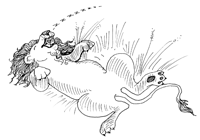STRANGE BUT TRUE- In the jungle: Why the lion sleeps two nights

DRAWING BY DEBORAH DERR McCLINTOCK
Q. "Bedtime" in the animal kingdom: How crazy can things get? –L.E. Mur
A. With fish, so primitive are their nervous systems, you can't even be sure they sleep, says Israeli researcher Peretz Lavie in The Enchanted World of Sleep. At times, they swim around continuously, then sink to the bottom motionless awhile. If disturbed, they'll move around again. So, were they sleeping? By a behavioral definition, yes.
Some say you can safely grab onto the tail of a shark that's resting motionless (asleep?) at the bottom, though Lavie says he has no plans to verify this for himself.
Among birds, many sleep for brief episodes, followed by open-eye periods of quietude ("vigilant sleep"). Some seem to sleep with one eye open, perhaps resting a single brain hemisphere at a time; others sleep standing on one leg.
Elephants sleep three to six hours, two of them while standing up. Dozing dolphins in aquariums usually swim in circles, without changing directions.
The sleep of large predators usually exceeds that of their prey, who dare steal only a few winks at a time. A lion, snooze-king of the beasts, will leisurely munch leg of antelope, then turn belly up and sleep continuously for a couple of days.
Q. To control speeders, today's traffic engineers use "speed bumps," "speed humps," and even wider "speed tables," all fancifully known as "sleeping policemen." Are you up to speed on other traffic lingo? –M. Flaherty
A. A "mobile speed bump" is a car going at the speed limit and forcing others to do the same, a "speed cushion" has multiple small bumps with barely enough room between for a tire to fit, says Paul McFedries in IEEE Spectrum magazine. A "neck down" is a curb that extends into the street at an intersection. And in reckless-drivered New Delhi, natural "traffic-calming" cattle will often lounge right in the middle of the road.
Some engineers have taken psychology to the extreme and advocated "naked streets" without signs, road markings, or traffic lights, forcing drivers to pay closer attention and drive responsibly on their own initiative.
Historical footnote: In 1861, steam-powered automobiles ("road locomotives") prompted the British Parliament to establish the world's first speed limit of 10 mph (16 kph). Four years later, this was slashed to 4 mph in the country and 2 mph in towns and villages. It was also decreed that each vehicle had to be preceded by a person walking 60 yards ahead (about 55 meters) and waving a red flag warning of the approach. Nowadays, with some 40,000 traffic-related deaths annually in the U.S. alone, perhaps the case could be made that "we need even more sleeping policemen and armies of volunteers walking in front of cars and waving red flags."
Q. Why does an accident in the northbound lanes of a divided highway tend to jam up the southbound lanes as well? Hint: Think cost-benefit analysis. –J. Miller
A. For southbound-rubberneckers, the cost of slowing down for a closer look is a delay of several seconds, while the benefit is satisfaction of curiosity, obviously deemed a good tradeoff by most motorists, explains Robert Frank in The Economic Naturalist. What they don't consider, of course, is that their decision to slow also creates several seconds' delay for each of the hundreds of motorists behind them, adding up to an hour-long jam-up. It seems unlikely that many motorists would be willing to endure an hour's delay for a better look, but they make their decisions individually upon reaching the spot of the accident. This is just another instance of the well-known social trap of "the tragedy of the commons," or "smart for one, dumb for all."
~
Send Strange questions to brothers Bill and Rich at [email protected].
#